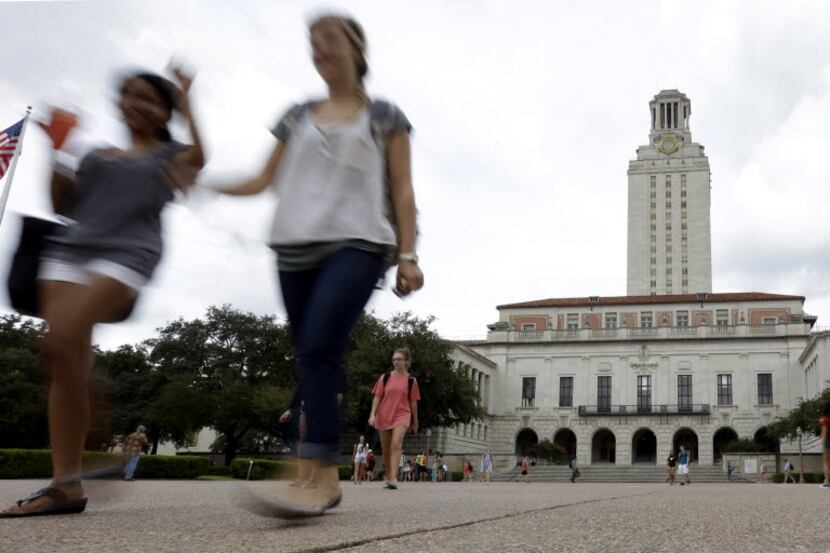AUSTIN — The University of Texas’ decision to leave the Big 12 athletic conference is causing what one expert calls “the plebeians” among state universities to revolt.
Long-simmering disgruntlement over short state rations has erupted into rage — and demands that the Legislature debate the fairness of a nearly 150-year-old funding system tilted heavily toward UT, Texas A&M University and their systems of four-year colleges and medical centers.
“There’s been discontent about this for quite some time, and particularly for Tech and U of H,” noted Rice University political scientist Mark Jones, speaking of Texas Tech and the University of Houston.
“But for at least the Tech supporters, the departure of UT from the Big 12 was the straw that broke the camel’s back, converting that anger inside them into loud shouts,” Jones said. He referred to decisions unveiled this past summer by UT and the University of Oklahoma that they were bolting the Big 12 and joining the uber-rich Southeastern Conference.
UT’s conference switch infuriated Baylor and Texas Christian fans, not just Red Raiders in Lubbock, because it jeopardized the Big 12′s future TV contracts and ability to remain a “Power Five” conference — one that usually competes for an NCAA Division I football championship.
Political repercussions for UT, though, may just be beginning. In the year’s third special legislative session, two influential Lubbock lawmakers filed measures that would cut in half the sprawling UT System’s $1.7 billion drawdown from the Permanent University Fund in the current two-year budget cycle.
The endowment, mostly consisting of state-owned lands in West Texas where oil and gas was discovered, had an investment portfolio worth $24 billion in August 2020. The fund, whose land values are believed to be worth as much or more, also is scheduled to spin off $828.4 million to the Texas A&M University System in the two-year budget cycle that began last month.
But “the PUF,” as it’s called, does nothing for the state universities such as Texas Tech and UH that are “flagships” of much smaller public higher education systems — and also avidly desire more money for pure research, which is the ticket to both prestige, and as it turns out, the best football conferences.
Tech, UH, UT-Dallas and UT-Arlington are eligible to receive from the state’s National Research University Fund, created in 2009. Budget documents, though, show the fund will distribute only about $25 million a year — total — in the current cycle.
“That’s a drop in the bucket compared to what A&M and UT get from the PUF,” said Jones, the Rice professor.
He called National Research University Fund recipient schools, which soon could also include UT-El Paso and UT-San Antonio, “the plebeians of the state university system.”
Sen. Charles Perry and Rep. Dustin Burrows, both Lubbock Republicans, have begun a push to let those schools share in the PUF, or short of that, shove some new state dollars their way.
‘Misallocation of resources’?
In the past week, House Appropriations Committee Chairman Greg Bonnen put into his supplemental appropriations bills a provision that would help the Texas Tech and UH systems augment their research efforts with a new $2 billion endowment.
Bonnen’s language assumes that Burrows could pass a separate bill and that voters next May would approve the concept, submitted to them as a constitutional amendment. In Bonnen’s first draft, the money would come from the state’s “rainy day fund.” But more recently, he proposed taking $2 billion of the more than $16 billion that is Texas’ share of President Joe Biden’s pandemic relief money, and using it to seed the proposed Texas University Fund.
Lubbock lawmakers Perry and Burrows are sharing with colleagues a one-page document called “Comparison of State Support.”
In the next fiscal year, the flagship campuses of four systems would get widely disparate amounts of institutional enhancement and research money from the state, it shows: UT-Austin, about $505 million; A&M College Station, $208 million; UH’s main campus, $26 million; and Tech’s Lubbock campus, $21 million.
The Lubbockites’ sheet omits amounts that Tech and UH get — about $50 million a year each — from the Higher Education Fund, created in 1985 for non-PUF schools. And UT and A&M’s larger enrollments aren’t factored in. Burrows, though, said he left out the Higher Education Fund because he wanted to focus on research funding. He also omitted “the funding UT Austin & TAMU receive in PUF [construction] bond proceeds,” he tweeted. However they are viewed, he insisted, the funding gaps are large.
“It’s obscene,” added Perry, who is a Senate budget writer and chairman of the chamber’s Water, Agriculture and Rural Affairs Committee. “The average person would know that it is. Most people, if they’re honest, would say it’s not right.”

Burrows, who is chairman of the influential House Calendars Committee, observed, “Do we have a misallocation of resources amongst the universities? I don’t think anybody ever dreamed the PUF would grow as big as it has become.”
Both noted the irony that West Texas’ mineral wealth has flowed to build fine buildings and support operations at the “40 Acres” in Austin and at Aggieland in College Station.
The comparatively paltry state support of Texas Tech and UH’s research efforts inflicts a double whammy, noted Jones, who is chairman of the Rice Faculty Senate’s athletics committee.
A peculiar credential needed to get into a good athletic conference is an invitation to belong to the American Association of Universities, he explained. Founded in 1900, the AAU, with 66 public and private schools as members, touts itself as a group of “leading comprehensive research universities distinguished by the breadth and quality of their programs of research and graduate education.”
In theory, schools “whose research and education profile falls significantly below that of other current members” can be expelled. And similarly, up-and-comers who raise their academic “profiles” can be admitted, the group’s website says. There’s no set number of slots but the members want to keep it as small as possible.
“From a pure research perspective, Texas is substantially behind California but also even New York,” Jones said. “California has 10 AAU members. New York has six. We have three,” which are UT-Austin, A&M, and since 1985, Rice. “Iowa has as many public universities in AAU as Texas does, with one-seventh of Texas’ population,” he said.

‘Insult to injury’
For Texas Tech, which is worried the Big 12 is no longer going to be considered a top athletic conference, and UH, which is set to leave the American Athletic Conference and join the Big 12, being excluded from the academically elite AAU hurts, Jones noted.
The Big 10 requires a new member to be in the AAU, and the Pac-12 strongly prefers it, he said.
“That just adds insult to injury” for Tech and UH, he said. “Not only does the lack of resources allow UT to leave them behind but then their two best options, to move to a ‘now-Power Four conference,’ are thwarted by the fact that they aren’t AAU institutions.”
Spokesmen for UT-Austin and the UT System declined to respond to queries about the fairness of current state funding of higher education, the accuracy of Perry and Burrows’ report and the two lawmakers’ bills that would reallocate UT-Austin’s PUF money to the emerging research schools or Burrows’ House Joint Resolution 13, which would create the proposed Texas Education Fund.

Speaker Dade Phelan, a UT-Austin graduate, has not referred HJR 13 to a committee. On Thursday, Phelan was said to be traveling and could not be reached for comment.
Perry, an accountant and land developer, and Tech alumnus, said that even if he and Burrows can’t achieve any forward movement in the time remaining in the current special session, they intend to engage lawmakers in a comprehensive discussion of funding fairness before the 2023 regular session.
“Football is football. We all like our football. But when you’re told you don’t meet the research standards in order to even qualify for a conference conversation somewhere else,” it’s infuriating, he said. “There’s no reason we shouldn’t have four AAU-qualified universities in Texas. Or however many qualify. We are too wealthy, too rich, too forward-thinking.”
Burrows, a trial lawyer who’s also a Tech alum, also urged the state to aspire to more.
“I’m not necessarily saying that I want to take something from UT to teach them a lesson,” he said. “The point is, there’s other schools out there, there’s other systems out there. If everybody’s getting all the resources and these other ones are left out, it’s no wonder they’re not able to achieve this recognition and grow. And we as a state should want more than just two [public schools in the AAU], in my opinion.”
CORRECTION, 1:20 p.m., Oct. 8, 2021: An earlier version of this story incorrectly said that the Texas Tech and University of Houston main campuses receive about $10 million annually from the Higher Education Fund. Each receives about $50 million a year.

